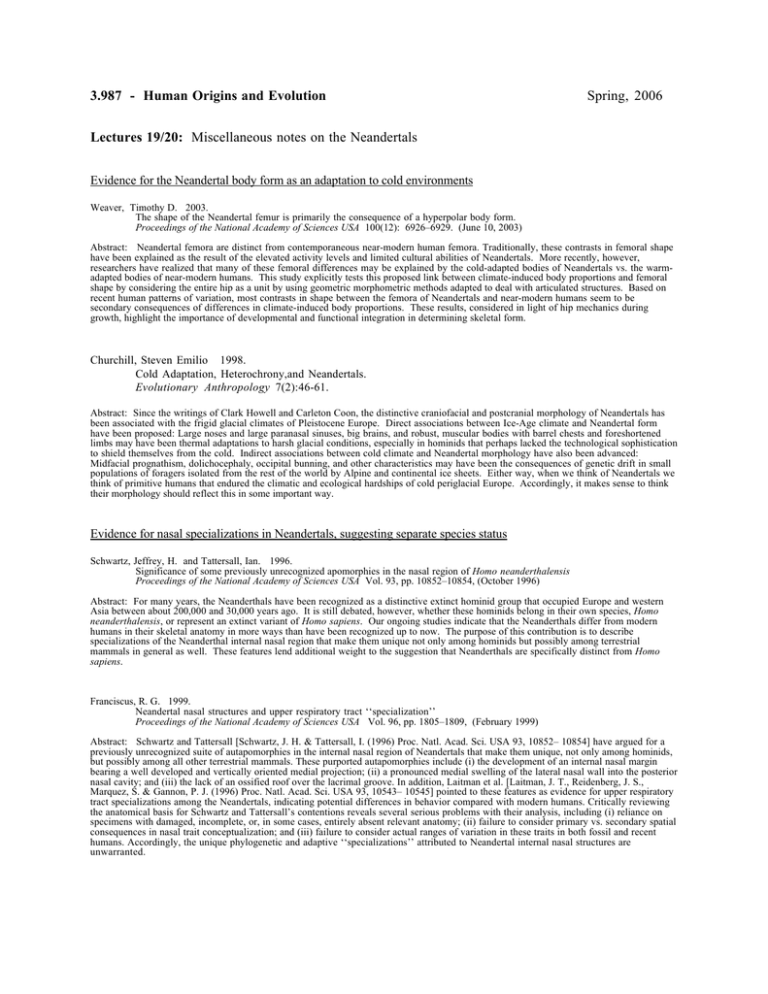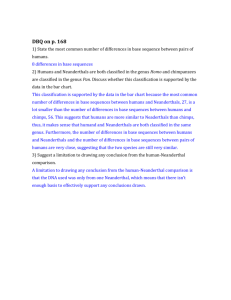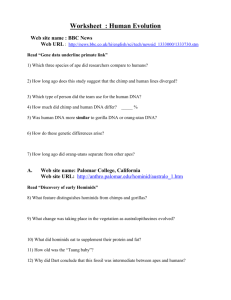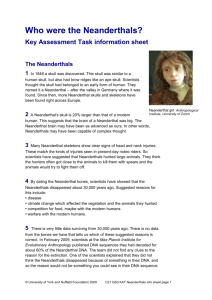3.987 - Human Origins and Evolution Lectures 19/20: Spring, 2006
advertisement

3.987 - Human Origins and Evolution Spring, 2006 Lectures 19/20: Miscellaneous notes on the Neandertals Evidence for the Neandertal body form as an adaptation to cold environments Weaver, Timothy D. 2003. The shape of the Neandertal femur is primarily the consequence of a hyperpolar body form. Proceedings of the National Academy of Sciences USA 100(12): 6926–6929. (June 10, 2003) Abstract: Neandertal femora are distinct from contemporaneous near-modern human femora. Traditionally, these contrasts in femoral shape have been explained as the result of the elevated activity levels and limited cultural abilities of Neandertals. More recently, however, researchers have realized that many of these femoral differences may be explained by the cold-adapted bodies of Neandertals vs. the warmadapted bodies of near-modern humans. This study explicitly tests this proposed link between climate-induced body proportions and femoral shape by considering the entire hip as a unit by using geometric morphometric methods adapted to deal with articulated structures. Based on recent human patterns of variation, most contrasts in shape between the femora of Neandertals and near-modern humans seem to be secondary consequences of differences in climate-induced body proportions. These results, considered in light of hip mechanics during growth, highlight the importance of developmental and functional integration in determining skeletal form. Churchill, Steven Emilio 1998. Cold Adaptation, Heterochrony,and Neandertals. Evolutionary Anthropology 7(2):46-61. Abstract: Since the writings of Clark Howell and Carleton Coon, the distinctive craniofacial and postcranial morphology of Neandertals has been associated with the frigid glacial climates of Pleistocene Europe. Direct associations between Ice-Age climate and Neandertal form have been proposed: Large noses and large paranasal sinuses, big brains, and robust, muscular bodies with barrel chests and foreshortened limbs may have been thermal adaptations to harsh glacial conditions, especially in hominids that perhaps lacked the technological sophistication to shield themselves from the cold. Indirect associations between cold climate and Neandertal morphology have also been advanced: Midfacial prognathism, dolichocephaly, occipital bunning, and other characteristics may have been the consequences of genetic drift in small populations of foragers isolated from the rest of the world by Alpine and continental ice sheets. Either way, when we think of Neandertals we think of primitive humans that endured the climatic and ecological hardships of cold periglacial Europe. Accordingly, it makes sense to think their morphology should reflect this in some important way. Evidence for nasal specializations in Neandertals, suggesting separate species status Schwartz, Jeffrey, H. and Tattersall, Ian. 1996. Significance of some previously unrecognized apomorphies in the nasal region of Homo neanderthalensis Proceedings of the National Academy of Sciences USA Vol. 93, pp. 10852–10854, (October 1996) Abstract: For many years, the Neanderthals have been recognized as a distinctive extinct hominid group that occupied Europe and western Asia between about 200,000 and 30,000 years ago. It is still debated, however, whether these hominids belong in their own species, Homo neanderthalensis, or represent an extinct variant of Homo sapiens. Our ongoing studies indicate that the Neanderthals differ from modern humans in their skeletal anatomy in more ways than have been recognized up to now. The purpose of this contribution is to describe specializations of the Neanderthal internal nasal region that make them unique not only among hominids but possibly among terrestrial mammals in general as well. These features lend additional weight to the suggestion that Neanderthals are specifically distinct from Homo sapiens. Franciscus, R. G. 1999. Neandertal nasal structures and upper respiratory tract ‘‘specialization’’ Proceedings of the National Academy of Sciences USA Vol. 96, pp. 1805–1809, (February 1999) Abstract: Schwartz and Tattersall [Schwartz, J. H. & Tattersall, I. (1996) Proc. Natl. Acad. Sci. USA 93, 10852– 10854] have argued for a previously unrecognized suite of autapomorphies in the internal nasal region of Neandertals that make them unique, not only among hominids, but possibly among all other terrestrial mammals. These purported autapomorphies include (i) the development of an internal nasal margin bearing a well developed and vertically oriented medial projection; (ii) a pronounced medial swelling of the lateral nasal wall into the posterior nasal cavity; and (iii) the lack of an ossified roof over the lacrimal groove. In addition, Laitman et al. [Laitman, J. T., Reidenberg, J. S., Marquez, S. & Gannon, P. J. (1996) Proc. Natl. Acad. Sci. USA 93, 10543– 10545] pointed to these features as evidence for upper respiratory tract specializations among the Neandertals, indicating potential differences in behavior compared with modern humans. Critically reviewing the anatomical basis for Schwartz and Tattersall’s contentions reveals several serious problems with their analysis, including (i) reliance on specimens with damaged, incomplete, or, in some cases, entirely absent relevant anatomy; (ii) failure to consider primary vs. secondary spatial consequences in nasal trait conceptualization; and (iii) failure to consider actual ranges of variation in these traits in both fossil and recent humans. Accordingly, the unique phylogenetic and adaptive ‘‘specializations’’ attributed to Neandertal internal nasal structures are unwarranted. Evidence for differences in manipulatory abilities between Neandertals and moderns. Niewoehner, Wesley A. 2001. Behavioral inferences from the Skhul/Qafzeh early modern human hand remains. Proceedings of the National Academy of Sciences USA, 98(6): 2979–2984. (March 13, 2001) Abstract: Two groups of humans are found in the Near East '100,000 years ago, the late archaic Neanderthals and the early modern Skhul/Qafzeh humans. Observations that Neanderthals were more heavily muscled, had stronger upper-limb bones, and possessed unusual shapes and orientations of some upper-limb joint complexes relative to the Skhul/Qafzeh hominids, have led some researchers to conclude that significant between-group upper-limb-related behavioral differences must have been present, despite the association of the two groups with similar Middle Paleolithic archeological complexes. A three-dimensional morphometric analysis of the hand remains of the Skhul/Qafzeh hominids, Neanderthals, early and late Upper Paleolithic humans, and Holocene humans supports the dichotomy. The Skhul/Qafzeh carpo­ metacarpal remains do not have any unique morphologies relative to the other fossil samples remains examined. However, in the functionally significant metacarpal 1 and 3 bases they resemble Upper Paleolithic humans, not Neanderthals. Furthermore, the Skhul/Qafzeh sample differs significantly from the Neanderthals in many other aspects of hand functional anatomy. Given the correlations between changes in tool technologies and functional adaptations seen in the hands of Upper Paleolithic humans, it is concluded that the Skhul/Qafzeh hand remains were adapted to Upper Paleolithic-like manipulative repertoires. These results support the inference of significant behavioral differences between Neanderthals and the Skhul/Qafzeh hominids and indicate that a significant shift in human manipulative behaviors was associated with the earliest stages of the emergence of modern humans. Evidence for Neandertal diet Michael P. Richards, Paul B. Pettitt, Erik Trinkaus, Fred H. Smith, Maja Paunovic, and Ivor Karavanic 2000. Neanderthal diet at Vindija and Neanderthal predation: The evidence from stable isotopes. Proceeding of the National Academy of Sciences USA 97(13):7663–7666 (June 20, 2000). Archeological analysis of faunal remains and of lithic and bone tools has suggested that hunting of medium to large mammals was a major element of Neanderthal subsistence. Plant foods are almost invisible in the archeological record, and it is impossible to estimate accurately their dietary importance. However, stable isotope ( d 13 C and d 15 N) analysis of mammal bone collagen provides a direct measure of diet and has been applied to two Neanderthals and various faunal species from Vindija Cave, Croatia. The isotope evidence overwhelmingly points to the Neanderthals behaving as top-level carnivores, obtaining almost all of their dietary protein from animal sources. Earlier Neanderthals in France and Belgium have yielded similar results, and a pattern of European Neanderthal adaptation as carnivores is emerging. These data reinforce current taphonomic assessments of associated faunal elements and make it unlikely that the Neanderthals were acquiring animal protein principally through scavenging. Instead, these findings portray them as effective predators. Bocherens, H., D. Billiou, A. Mariotti, M. Toussaint, M. Patou-Mathis, D. Bonjean and M. Otte 2001 New isotopic evidence for dietary habits of Neandertals from Belgium Journal of Human Evolution (2001) 40, 497–505. 3.987 - Human Origins and Evolution Spring, 2006 Lectures 19/20: More miscellaneous notes on the Neandertals Evidence for interpersonal violence among Neanderthals Zollikofer, C.P.E., M.S. Ponce de León, B. Vandermeersch and F. Lévêque 2002 Evidence for interpersonal violence in the St. Césaire Neanderthal Proceeding of the National Academy of Sciences USA 99(9):6444-48. Abstract: The St. Césaire 1 Neanderthal skeleton of a young adult individual is unique in its association with Châtelperronian artifacts from a level dated to ca. 36,000 years ago. Computer-tomographic imaging and computer-assisted reconstruction of the skull revealed a healed fracture in the cranial vault. When paleopathological and forensic diagnostic standards are applied, the bony scar bears direct evidence for the impact of a sharp implement, which was presumably directed toward the individual during an act of interpersonal violence. These findings add to the evidence that Neanderthals used implements not only for hunting and food processing, but also in other behavioral contexts. It is hypothesized that the high intra-group damage potential inherent to weapons might have represented a major factor during the evolution of hominid social behavior. Evidence for Neandertal cannibalism Defleur, A., T. White, Patricia Valensi, L. Slimak and E. Crégut-Bonnoure. 1999 Neanderthal Cannibalism at Moula-Guercy, Ardéche, France. Science 286:128-131. Abstract: The cave site of Moula-Guercy, 80 meters above the modern Rhone River, was occupied by Neanderthals approximately 100,000 years ago. Excavations since 1991 have yielded rich paleontological, paleobotanical, and archaeological assemblages, including parts of six Neanderthals. The Neanderthals are contemporary with stone tools and faunal remains in the same tightly controlled stratigraphic and spatial contexts. The inference of Neanderthal cannibalism at Moula-Guercy is based on comparative analysis of hominid and ungulate bone spatial distributions, modifications by stone tools, and skeletal part representations. Magnified photograph of a radius bone showing clear cutmarks in the biciptal tuberosity removed due to copyright restrictions. Evidence for the Neandertal genetic contribution to modern humans Serre, D., A. Langaney, M. Chech, M. Teschler-Nicola, M. Paunovic, P. Mennecier, M. Hofreiter, G. Possnert, S. Pääbo. 2004 No evidence of Neandertal mtDNA contribution to early modern humans. PLoS Biology 2(3):0313-0317. Abstract: The retrieval of mitochondrial DNA (mtDNA) sequences from four Neandertal fossils from Germany, Russia, and Croatia has demonstrated that these individuals carried closely related mtDNAs that are not found among current humans. However, these results do not definitively resolve the question of a possible Neandertal contribution to the gene pool of modern humans since such a contribution might have been erased by genetic drift or by the continuous influx of modern human DNA into the Neandertal gene pool. A further concern is that if some Neandertals carried mtDNA sequences similar to contemporaneous humans, such sequences may be erroneously regarded as modern contaminations when retrieved from fossils. Here we address these issues by the analysis of 24 Neandertal and 40 early modern human remains. The biomolecular preservation of four Neandertals and of five early modern humans was good enough to suggest the preservation of DNA. All four Neandertals yielded mtDNA sequences similar to those previously determined from Neandertal individuals, whereas none of the five early modern humans contained such mtDNA sequences. In combination with current mtDNA data, this excludes any large genetic contribution by Neandertals to early modern humans, but does not rule out the possibility of a smaller contribution. Currat, M. and L. Excoffier 2004 Modern humans did not admix with Neanderthals during their range expansion into Europe. PLoS Biology 2(12) 2264- 74. (e421) Abstract: The process by which the Neanderthals were replaced by modern humans between 42,000 and 30,000 before present is still intriguing. Although no Neanderthal mitochondrial DNA (mtDNA) lineage is found to date among several thousands of Europeans and in seven early modern Europeans, interbreeding rates as high as 25% could not be excluded between the two subspecies. In this study, we introduce a realistic model of the range expansion of early modern humans into Europe, and of their competition and potential admixture with local Neanderthals. Under this scenario, which explicitly models the dynamics of Neanderthals’ replacement, we estimate that maximum interbreeding rates between the two populations should have been smaller than 0.1%. We indeed show that the absence of Neanderthal mtDNA sequences in Europe is compatible with at most 120 admixture events between the two populations despite a likely cohabitation time of more than 12,000 y. This extremely low number strongly suggests an almost complete sterility between Neanderthal females and modern human males, implying that the two populations were probably distinct biological species.







